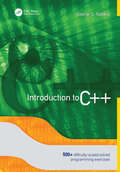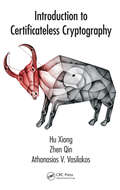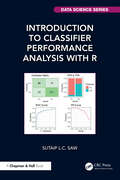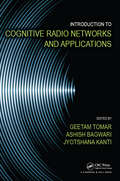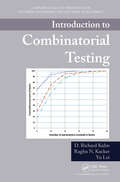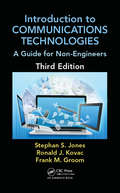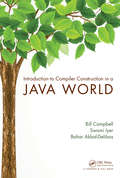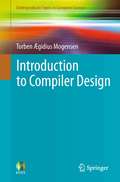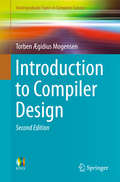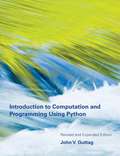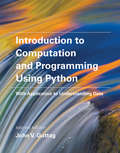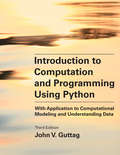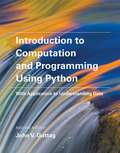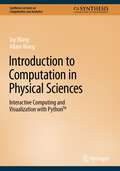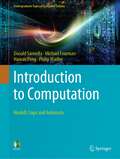- Table View
- List View
Introduction to Broadband Communication Systems
by Cajetan M. Akujuobi Matthew N.O. SadikuBroadband networks, such as asynchronous transfer mode (ATM), frame relay, and leased lines, allow us to easily access multimedia services (data, voice, and video) in one package. Exploring why broadband networks are important in modern-day telecommunications, Introduction to Broadband Communication Systems covers the concepts and components of bot
Introduction to C++
by George S. TselikisThis book is primarily for students who are taking a course on the C++ language, for those who wish to self-study the C++ language, and for programmers who have experience with C and want to advance to C++. It could also prove useful to instructors of the C++ course who are looking for explanatory programming examples to add in their lectures. The focus of this book is to provide a solid introduction to the C++ language and programming knowledge through a large number of practical examples and meaningful advice. It includes more than 500 exercises and examples of progressive difficulty to aid the reader in understanding the C++ principles and to see how concepts can materialize in code. The examples are designed to be short, concrete, and substantial, quickly giving the reader the ability to understand how to apply correctly and efficiently the features of the C++ language and to get a solid programming know-how. Rest assured that if you are able to understand this book’s examples and solve the exercises, you can safely go on to edit larger programs, you will be able to develop your own applications, and you will have certainly established a solid fundamental conceptual and practical background to expand your knowledge and skills.
Introduction to Certificateless Cryptography
by Athanasios V. Vasilakos Hu Xiong Zhen QinAs an intermediate model between conventional PKC and ID-PKC, CL-PKC can avoid the heavy overhead of certificate management in traditional PKC as well as the key escrow problem in ID-PKC altogether. Since the introduction of CL-PKC, many concrete constructions, security models, and applications have been proposed during the last decade. Differing from the other books on the market, this one provides rigorous treatment of CL-PKC.Definitions, precise assumptions, and rigorous proofs of security are provided in a manner that makes them easy to understand.
Introduction to Classifier Performance Analysis with R (Chapman & Hall/CRC Data Science Series)
by Sutaip L.C. SawClassification problems are common in business, medicine, science, engineering and other sectors of the economy. Data scientists and machine learning professionals solve these problems through the use of classifiers. Choosing one of these data driven classification algorithms for a given problem is a challenging task. An important aspect involved in this task is classifier performance analysis (CPA). Introduction to Classifier Performance Analysis with R provides an introductory account of commonly used CPA techniques for binary and multiclass problems, and use of the R software system to accomplish the analysis. Coverage draws on the extensive literature available on the subject, including descriptive and inferential approaches to CPA. Exercises are included at the end of each chapter to reinforce learning.Key Features: An introduction to binary and multiclass classification problems is provided, including some classifiers based on statistical, machine and ensemble learning. Commonly used techniques for binary and multiclass CPA are covered, some from less well-known but useful points of view. Coverage also includes important topics that have not received much attention in textbook accounts of CPA. Limitations of some commonly used performance measures are highlighted. Coverage includes performance parameters and inferential techniques for them. Also covered are techniques for comparative analysis of competing classifiers. A key contribution involves the use of key R meta-packages like tidyverse and tidymodels for CPA, particularly the very useful yardstick package. This is a useful resource for upper level undergraduate and masters level students in data science, machine learning and related disciplines. Practitioners interested in learning how to use R to evaluate classifier performance can also potentially benefit from the book. The material and references in the book can also serve the needs of researchers in CPA.
Introduction to Coding Theory (Discrete Mathematics and Its Applications #5)
by Jurgen BierbrauerAlthough its roots lie in information theory, the applications of coding theory now extend to statistics, cryptography, and many areas of pure mathematics, as well as pervading large parts of theoretical computer science, from universal hashing to numerical integration.Introduction to Coding Theory introduces the theory of error-correcting codes in a thorough but gentle presentation. Part I begins with basic concepts, then builds from binary linear codes and Reed-Solomon codes to universal hashing, asymptotic results, and 3-dimensional codes. Part II emphasizes cyclic codes, applications, and the geometric desciption of codes. The author takes a unique, more natural approach to cyclic codes that is not couched in ring theory but by virtue of its simplicity, leads to far-reaching generalizations. Throughout the book, his discussions are packed with applications that include, but reach well beyond, data transmission, with each one introduced as soon as the codes are developed.Although designed as an undergraduate text with myriad exercises, lists of key topics, and chapter summaries, Introduction to Coding Theory explores enough advanced topics to hold equal value as a graduate text and professional reference. Mastering the contents of this book brings a complete understanding of the theory of cyclic codes, including their various applications and the Euclidean algorithm decoding of BCH-codes, and carries readers to the level of the most recent research.
Introduction to Coding Theory (Discrete Mathematics and Its Applications)
by Jurgen BierbrauerThis book is designed to be usable as a textbook for an undergraduate course or for an advanced graduate course in coding theory as well as a reference for researchers in discrete mathematics, engineering and theoretical computer science. This second edition has three parts: an elementary introduction to coding, theory and applications of codes, and algebraic curves. The latter part presents a brief introduction to the theory of algebraic curves and its most important applications to coding theory.
Introduction to Cognitive Radio Networks and Applications
by GEETAM TOMAR, ASHISH BAGWARI AND JYOTSHANA KANTICognitive radio is 5-G technology, comes under IEEE 802.22 WRAN (Wireless Regional Area Network) standards. It is currently experiencing rapid growth due to its potential to solve many of the problems affecting present-day wireless systems. The foremost objective of "Introduction to Cognitive Radio Networks and Applications" is to educate wireless communication generalists about cognitive radio communication networks. Written by international leading experts in the field, this book caters to the needs of researchers in the field who require a basis in the principles and the challenges of cognitive radio networks.
Introduction to Combinatorial Designs (Discrete Mathematics and Its Applications)
by W.D. WallisCombinatorial theory is one of the fastest growing areas of modern mathematics. Focusing on a major part of this subject, Introduction to Combinatorial Designs, Second Edition provides a solid foundation in the classical areas of design theory as well as in more contemporary designs based on applications in a variety of fields.After an o
Introduction to Combinatorial Testing (Chapman & Hall/CRC Innovations in Software Engineering and Software Development Series)
by Yu Lei D. Richard Kuhn Raghu N. KackerCombinatorial testing of software analyzes interactions among variables using a very small number of tests. This advanced approach has demonstrated success in providing strong, low-cost testing in real-world situations. Introduction to Combinatorial Testing presents a complete self-contained tutorial on advanced combinatorial testing methods for re
Introduction to Communications Technologies: A Guide for Non-Engineers, Third Edition
by Stephan Jones Ronald J. Kovac Frank M. GroomThanks to the advancement of faster processors within communication devices, there has been a rapid change in how information is modulated, multiplexed, managed, and moved. While formulas and functions are critical in creating the granular components and operations of individual technologies, understanding the applications and their purposes in the
Introduction to Compiler Construction in a Java World
by Bill Campbell Swami Iyer Bahar Akbal-DelibasImmersing students in Java and the JVM, this text enables a deep understanding of the Java programming language and its implementation. It focuses on design, organization, and testing, helping students learn good software engineering skills and become better programmers. By working with and extending a real, functional compiler, students develop a hands-on appreciation of how compilers work, how to write compilers, and how the Java language behaves. Fully documented Java code for the compiler is accessible on a supplementary website.
Introduction to Compiler Design
by Torben Ægidius MogensenThis textbook is intended for an introductory course on Compiler Design, suitable for use in an undergraduate programme in computer science or related fields. Introduction to Compiler Design presents techniques for making realistic, though non-optimizing compilers for simple programming languages using methods that are close to those used in "real" compilers, albeit slightly simplified in places for presentation purposes. All phases required for translating a high-level language to machine language is covered, including lexing, parsing, intermediate-code generation, machine-code generation and register allocation. Interpretation is covered briefly. Aiming to be neutral with respect to implementation languages, algorithms are presented in pseudo-code rather than in any specific programming language, and suggestions for implementation in several different language flavors are in many cases given. The techniques are illustrated with examples and exercises. The author has taught Compiler Design at the University of Copenhagen for over a decade, and the book is based on material used in the undergraduate Compiler Design course there. Additional material for use with this book, including solutions to selected exercises, is available at http://www.diku.dk/~torbenm/ICD
Introduction to Compiler Design
by Torben Ægidius MogensenThis textbook is intended for an introductory course on Compiler Design, suitable for use in an undergraduate programme in computer science or related fields. Introduction to Compiler Design presents techniques for making realistic, though non-optimizing compilers for simple programming languages using methods that are close to those used in "real" compilers, albeit slightly simplified in places for presentation purposes. All phases required for translating a high-level language to machine language is covered, including lexing, parsing, intermediate-code generation, machine-code generation and register allocation. Interpretation is covered briefly. Aiming to be neutral with respect to implementation languages, algorithms are presented in pseudo-code rather than in any specific programming language, and suggestions for implementation in several different language flavors are in many cases given. The techniques are illustrated with examples and exercises. The author has taught Compiler Design at the University of Copenhagen for over a decade, and the book is based on material used in the undergraduate Compiler Design course there. Additional material for use with this book, including solutions to selected exercises, is available at http://www. diku. dk/~torbenm/ICD
Introduction to Compiler Design (Undergraduate Topics in Computer Science)
by Torben Ægidius MogensenThe third edition of this textbook has been fully revised and adds material about the SSA form, polymorphism, garbage collection, and pattern matching. It presents techniques for making realistic compilers for simple to intermediate-complexity programming languages. The techniques presented in the book are close to those used in professional compilers, albeit in places slightly simplified for presentation purposes. "Further reading" sections point to material about the full versions of the techniques.All phases required for translating a high-level language to symbolic machine language are covered, and some techniques for optimising code are presented. Type checking and interpretation are also included.Aiming to be neutral with respect to implementation languages, algorithms are mostly presented in pseudo code rather than in any specific language, but suggestions are in many places given for how these can be realised in different language paradigms.Depending on how much of the material from the book is used, it is suitable for both undergraduate and graduate courses for introducing compiler design and implementation.
Introduction to Computation and Programming Using Python
by John V. GuttagThis book introduces students with little or no prior programming experience to the art of computational problem solving using Python and various Python libraries, including PyLab. It provides students with skills that will enable them to make productive use of computational techniques, including some of the tools and techniques of "data science" for using computation to model and interpret data. The book is based on an MIT course (which became the most popular course offered through MITs OpenCourseWare) and was developed for use not only in a conventional classroom but in in a massive open online course (or MOOC) offered by the pioneering MIT--Harvard collaboration edX. Students are introduced to Python and the basics of programming in the context of such computational concepts and techniques as exhaustive enumeration, bisection search, and efficient approximation algorithms. The book does not require knowledge of mathematics beyond high school algebra, but does assume that readers are comfortable with rigorous thinking and not intimidated by mathematical concepts. Although it covers such traditional topics as computational complexity and simple algorithms, the book focuses on a wide range of topics not found in most introductory texts, including information visualization, simulations to model randomness, computational techniques to understand data, and statistical techniques that inform (and misinform) as well as two related but relatively advanced topics: optimization problems and dynamic programming. "Introduction to Computation and Programming Using Python" can serve as a stepping-stone to more advanced computer science courses, or as a basic grounding in computational problem solving for students in other disciplines.
Introduction to Computation and Programming Using Python
by John V. GuttagThis book introduces students with little or no prior programming experience to the art of computational problem solving using Python and various Python libraries, including PyLab. It provides students with skills that will enable them to make productive use of computational techniques, including some of the tools and techniques of "data science" for using computation to model and interpret data. The book is based on an MIT course (which became the most popular course offered through MIT's OpenCourseWare) and was developed for use not only in a conventional classroom but in a massive open online course (or MOOC) offered by the pioneering MIT-Harvard collaboration edX.Students are introduced to Python and the basics of programming in the context of such computational concepts and techniques as exhaustive enumeration, bisection search, and efficient approximation algorithms. The book does not require knowledge of mathematics beyond high school algebra, but does assume that readers are comfortable with rigorous thinking and not intimidated by mathematical concepts. Although it covers such traditional topics as computational complexity and simple algorithms, the book focuses on a wide range of topics not found in most introductory texts, including information visualization, simulations to model randomness, computational techniques to understand data, and statistical techniques that inform (and misinform) as well as two related but relatively advanced topics: optimization problems and dynamic programming. Introduction to Computation and Programming Using Python can serve as a stepping-stone to more advanced computer science courses, or as a basic grounding in computational problem solving for students in other disciplines.
Introduction to Computation and Programming Using Python, revised and expanded edition: With Application To Understanding Data
by John V. GuttagAn introductory text that teaches students the art of computational problem solving, covering topics that range from simple algorithms to information visualization.This book introduces students with little or no prior programming experience to the art of computational problem solving using Python and various Python libraries, including PyLab. It provides students with skills that will enable them to make productive use of computational techniques, including some of the tools and techniques of “data science” for using computation to model and interpret data. The book is based on an MIT course (which became the most popular course offered through MIT's OpenCourseWare) and was developed for use not only in a conventional classroom but in a massive open online course (or MOOC) offered by the pioneering MIT-Harvard collaboration edX.Students are introduced to Python and the basics of programming in the context of such computational concepts and techniques as exhaustive enumeration, bisection search, and efficient approximation algorithms. The book does not require knowledge of mathematics beyond high school algebra, but does assume that readers are comfortable with rigorous thinking and not intimidated by mathematical concepts. Although it covers such traditional topics as computational complexity and simple algorithms, the book focuses on a wide range of topics not found in most introductory texts, including information visualization, simulations to model randomness, computational techniques to understand data, and statistical techniques that inform (and misinform) as well as two related but relatively advanced topics: optimization problems and dynamic programming.Introduction to Computation and Programming Using Python can serve as a stepping-stone to more advanced computer science courses, or as a basic grounding in computational problem solving for students in other disciplines.
Introduction to Computation and Programming Using Python, second edition: With Application to Understanding Data (The\mit Press Ser.)
by John V. GuttagThe new edition of an introductory text that teaches students the art of computational problem solving, covering topics ranging from simple algorithms to information visualization.This book introduces students with little or no prior programming experience to the art of computational problem solving using Python and various Python libraries, including PyLab. It provides students with skills that will enable them to make productive use of computational techniques, including some of the tools and techniques of data science for using computation to model and interpret data. The book is based on an MIT course (which became the most popular course offered through MIT's OpenCourseWare) and was developed for use not only in a conventional classroom but in in a massive open online course (MOOC). This new edition has been updated for Python 3, reorganized to make it easier to use for courses that cover only a subset of the material, and offers additional material including five new chapters.Students are introduced to Python and the basics of programming in the context of such computational concepts and techniques as exhaustive enumeration, bisection search, and efficient approximation algorithms. Although it covers such traditional topics as computational complexity and simple algorithms, the book focuses on a wide range of topics not found in most introductory texts, including information visualization, simulations to model randomness, computational techniques to understand data, and statistical techniques that inform (and misinform) as well as two related but relatively advanced topics: optimization problems and dynamic programming. This edition offers expanded material on statistics and machine learning and new chapters on Frequentist and Bayesian statistics.
Introduction to Computation and Programming Using Python, third edition: With Application to Computational Modeling and Understanding Data
by John V. GuttagThe new edition of an introduction to the art of computational problem solving using Python.This book introduces students with little or no prior programming experience to the art of computational problem solving using Python and various Python libraries, including numpy, matplotlib, random, pandas, and sklearn. It provides students with skills that will enable them to make productive use of computational techniques, including some of the tools and techniques of data science for using computation to model and interpret data as well as substantial material on machine learning. All of the code in the book and an errata sheet are available on the book&’s web page on the MIT Press website.
Introduction to Computation and Programming Using Python: With Application to Understanding Data
by John V. GuttagThis book introduces students with little or no prior programming experience to the art of computational problem solving using Python and various Python libraries, including PyLab. It provides students with skills that will enable them to make productive use of computational techniques, including some of the tools and techniques of data science for using computation to model and interpret data. The book is based on an MIT course (which became the most popular course offered through MIT's OpenCourseWare) and was developed for use not only in a conventional classroom but in in a massive open online course (MOOC). This new edition has been updated for Python 3, reorganized to make it easier to use for courses that cover only a subset of the material, and offers additional material including five new chapters.Students are introduced to Python and the basics of programming in the context of such computational concepts and techniques as exhaustive enumeration, bisection search, and efficient approximation algorithms. Although it covers such traditional topics as computational complexity and simple algorithms, the book focuses on a wide range of topics not found in most introductory texts, including information visualization, simulations to model randomness, computational techniques to understand data, and statistical techniques that inform (and misinform) as well as two related but relatively advanced topics: optimization problems and dynamic programming. This edition offers expanded material on statistics and machine learning and new chapters on Frequentist and Bayesian statistics.
Introduction to Computation in Physical Sciences: Interactive Computing and Visualization with Python™ (Synthesis Lectures on Computation and Analytics)
by Adam Wang Jay WangThis book provides a practical and comprehensive introduction to computational problem solving from the viewpoints of practitioners in both academic and industrial worlds. The authors present scientific problem-solving using computation and aim to increase computational thinking, which is the mindset and skillset required to solve scientific problems with computational methodologies via model building, simulation, data analysis, and visualization using the Python programming language. Topics and examples span fundamental areas of physical science as well as contemporary topics including quantum computing, neural networks, machine learning, global warming, and energy balance. The book features unique and innovative techniques and practices including: intentional scaffolding to help beginners learn computational problem solving; multimodal computing environments including cloud-based platforms and just-in-time computing; emphasis and connection between both numerical and symbolic computations; and extensive exercise sets carefully designed for further exploration as project assignments or self-paced study. The book is suitable for introductory level readers in physical sciences, engineering, and related STEM disciplines. Specifically, the book is appropriate for use in either a standalone course on computation and modeling and as a resource for readers interested in learning about proven techniques in interactive computing.
Introduction to Computation: Haskell, Logic and Automata (Undergraduate Topics in Computer Science)
by Philip Wadler Donald Sannella Michael Fourman Haoran PengComputation, itself a form of calculation, incorporates steps that include arithmetical and non-arithmetical (logical) steps following a specific set of rules (an algorithm). This uniquely accessible textbook introduces students using a very distinctive approach, quite rapidly leading them into essential topics with sufficient depth, yet in a highly intuitive manner. From core elements like sets, types, Venn diagrams and logic, to patterns of reasoning, calculus, recursion and expression trees, the book spans the breadth of key concepts and methods that will enable students to readily progress with their studies in Computer Science.
Introduction to Computational Engineering with MATLAB® (Chapman & Hall/CRC Numerical Analysis and Scientific Computing Series)
by Timothy BowerIntroduction to Computational Engineering with MATLAB® aims to teach readers how to use MATLAB programming to solve numerical engineering problems. The book focuses on computational engineering with the objective of helping engineering students improve their numerical problem-solving skills. The book cuts a middle path between undergraduate texts that simply focus on programming and advanced mathematical texts that skip over foundational concepts, feature cryptic mathematical expressions, and do not provide sufficient support for novices.Although this book covers some advanced topics, readers do not need prior computer programming experience or an advanced mathematical background. Instead, the focus is on learning how to leverage the computer and software environment to do the hard work. The problem areas discussed are related to data-driven engineering, statistics, linear algebra, and numerical methods. Some example problems discussed touch on robotics, control systems, and machine learning.Features: Demonstrates through algorithms and code segments how numeric problems are solved with only a few lines of MATLAB code Quickly teaches students the basics and gets them started programming interesting problems as soon as possible No prior computer programming experience or advanced math skills required Suitable for students at undergraduate level who have prior knowledge of college algebra, trigonometry, and are enrolled in Calculus I MATLAB script files, functions, and datasets used in examples are available for download from http://www.routledge.com/9781032221410.
Introduction to Computational Health Informatics (Chapman & Hall/CRC Data Mining and Knowledge Discovery Series)
by Arvind Kumar Bansal Javed Iqbal Khan S. Kaisar AlamThis class-tested textbook is designed for a semester-long graduate or senior undergraduate course on Computational Health Informatics. The focus of the book is on computational techniques that are widely used in health data analysis and health informatics and it integrates computer science and clinical perspectives. This book prepares computer science students for careers in computational health informatics and medical data analysis. Features Integrates computer science and clinical perspectives Describes various statistical and artificial intelligence techniques, including machine learning techniques such as clustering of temporal data, regression analysis, neural networks, HMM, decision trees, SVM, and data mining, all of which are techniques used widely used in health-data analysis Describes computational techniques such as multidimensional and multimedia data representation and retrieval, ontology, patient-data deidentification, temporal data analysis, heterogeneous databases, medical image analysis and transmission, biosignal analysis, pervasive healthcare, automated text-analysis, health-vocabulary knowledgebases and medical information-exchange Includes bioinformatics and pharmacokinetics techniques and their applications to vaccine and drug development
Introduction to Computational Modeling Using C and Open-Source Tools
by Jose M. GarridoIntroduction to Computational Modeling Using C and Open-Source Tools presents the fundamental principles of computational models from a computer science perspective. It explains how to implement these models using the C programming language. The software tools used in the book include the Gnu Scientific Library (GSL), which is a free software libra

